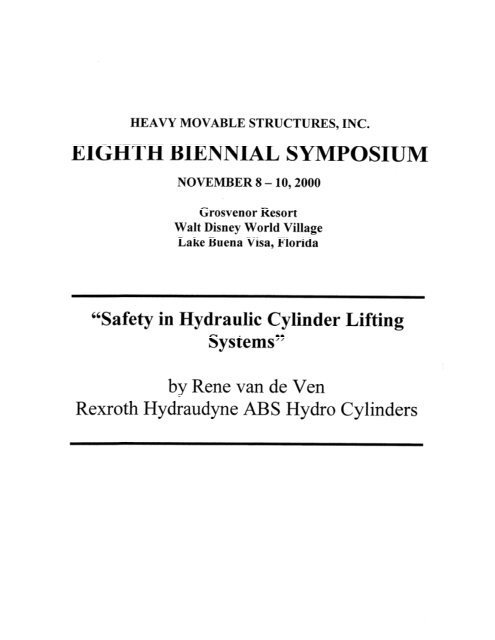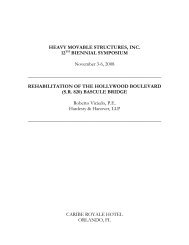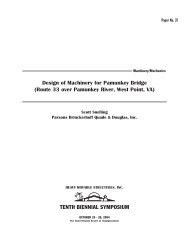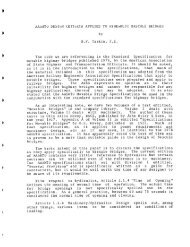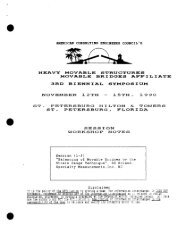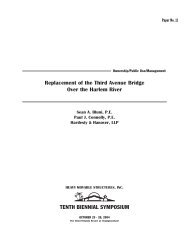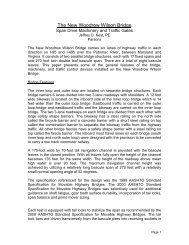Safety in Hydraulic Cylinder Lifting Systems - Heavy Movable ...
Safety in Hydraulic Cylinder Lifting Systems - Heavy Movable ...
Safety in Hydraulic Cylinder Lifting Systems - Heavy Movable ...
You also want an ePaper? Increase the reach of your titles
YUMPU automatically turns print PDFs into web optimized ePapers that Google loves.
HEAVY MOVABLE STRUCTURES, INC.<br />
EIGHTH BIENNIAL SYMPOSIUM<br />
NOVEMBER 8 - 10,2000<br />
Grosvenor Resort<br />
Walt Disney World Village<br />
Lake Buena Visa, Florida<br />
"<strong>Safety</strong> <strong>in</strong> <strong>Hydraulic</strong> Cyl<strong>in</strong>der Lift<strong>in</strong>g<br />
<strong>Systems</strong>"<br />
by Rene van de Ven<br />
Rexroth Hydraudyne AB S Hydro Cyl<strong>in</strong>ders
By: Rene van de Ven'<br />
Intsodu&;tion:<br />
Remoth Hydraudyne from the Netherlands is the Center of Comwtence for the design and supply for<br />
applica~on based cyi<strong>in</strong>dem. In close coopra@on Wh OEM's, GonsulbnB and End-users aapplica%on demands<br />
a cyl<strong>in</strong>der concept is developed to meet the specific applicagon demands. After the concept has proved its<br />
purpose <strong>in</strong> the applicaeon, the design is qualified as ABS (Application Based Standard). Over the last decades<br />
numerous movable bridges around the world have been equipped with ABS bridge cyi<strong>in</strong>ders. On dose<br />
cooperaeon -%I Remoth Cowr8ion, Bethlehem, PA. and We Rexro% Center of Competence for cG@t<br />
englneedng <strong>in</strong> Lohr, Germany, Rexroth supplies turn key drive systems to the Amerian market.<br />
ABS Appiieation Based Standard<br />
The ABS cyl<strong>in</strong>der concept is based on three ma<strong>in</strong> piliars with basic reference to <strong>in</strong>bgwted system technology<br />
and unambiguous demarcagon of the dhe system and the mechanicas construdion. These ma<strong>in</strong> pillars<br />
COV€?F:<br />
o Influengal surround<strong>in</strong>g factors;<br />
BP Fu~&QBB~B~ of We l<strong>in</strong>ear motor m<strong>in</strong> the h?dcfraulic drive system;<br />
Requiremewb of the cyliradem as me~hanicai construcfion element.<br />
As a basis for the design of ABS cyl<strong>in</strong>ders the DIN 19704 is used. The specific requirements from the DIN for<br />
cyi<strong>in</strong>deir design are expla<strong>in</strong>ed later.
if we analyze the requiremenfs for these type of cylrl<strong>in</strong>deas related to the piliars on which the ABS concept is<br />
based we f<strong>in</strong>d the fotloMng:<br />
I Isrfiueneal surround<strong>in</strong>g factors;<br />
Bridges are iocated mostly h coastal or <strong>in</strong>dustrialized areas. This impties that the cyl<strong>in</strong>ders are subjected<br />
to an aggressive or salq en$ro-onment. The exposure to posSb8e air pollulion (Acid ra<strong>in</strong>) or a salt-water<br />
environment demands for high corrosive resistant design solutions.<br />
Funcgona&w of the f<strong>in</strong>ear motor m<strong>in</strong> the hydr~ulic drbe system;<br />
Tpiw3ly the bddge leafs are d&en by a set of Wo or four cyi<strong>in</strong>ders. L should be vesed &at the qi<strong>in</strong>ders<br />
have the capam to lift adlor hold the bpjdge <strong>in</strong> dynamic as wefl as static load skaQons. The position<br />
<strong>in</strong>dicator systems play a key mfe i4~ the safe and adequate control of the bridge ds'ie.<br />
1<br />
s Requirements of the cyl<strong>in</strong>ders as mechaniwl construction element of the total;<br />
As per DIN 397634 fhe hydraulic steeB structures <strong>in</strong> civil eng<strong>in</strong>eer<strong>in</strong>g should be designed for a life%me of 70<br />
years. For the drive system an expected lifegme of 35 years is required. W& dynamic loaded steels<br />
sbudures exceed<strong>in</strong>g a movement rate 0% 10,000 <strong>in</strong> 35 years the design should be based on an <strong>in</strong>%n$e<br />
Iifegme. As bridges fa!! Mh<strong>in</strong> this category the basis for deign of hydwu!ic cyl<strong>in</strong>ders <strong>in</strong> this aappliwgon is an<br />
<strong>in</strong>fr<strong>in</strong>ge Hifetime.<br />
EnvironmnftaI Cond%ions vs. Corrosion Protedion:<br />
Piston rods:<br />
The weakest and wlnerabie element <strong>in</strong> hydraulic cyl<strong>in</strong>ders was twelitionaliy the pidon rod. S<strong>in</strong>ce the<br />
<strong>in</strong>trdoction of the Ceramax coat<strong>in</strong>g <strong>in</strong> 1989 %his belongs to the past. S<strong>in</strong>ce the market <strong>in</strong>Qoduc%on "Classic"<br />
Ceramax is recog~ized as a trend sett<strong>in</strong>g superior piston rod coat<strong>in</strong>g for genera! applicaGons <strong>in</strong> c~rrosbe and<br />
abrasive envjronmenk dh proven track record. Ceramax is an <strong>in</strong>-house Rexroth Hydraudy~ae development.<br />
Well over 10.000 cyi<strong>in</strong>de~ are delweaed Mh Ceramax rod coat<strong>in</strong>g.<br />
In 1998 the possibil9 was created to develop and apply eng<strong>in</strong>eered coagngs for protedon (corrosion)<br />
aga<strong>in</strong>st extreme external <strong>in</strong>fluences based on new spragng techno1ogy as an add%on to the "Classic"<br />
Ceramax.<br />
Fufier developments %is new spwgng bechnsjogy offew, epsglneered coaBngs, total ~~otecGon<br />
aga<strong>in</strong>st extreme chemical attack such as exposure to 13.5% HCL <strong>in</strong> comb<strong>in</strong>ation with 4 5% HF.<br />
This new spragng process is based on the foilo~ng. The "classic" Ceramax is appPied us<strong>in</strong>g a plasma<br />
spray<strong>in</strong>g process. This peasma process is spray<strong>in</strong>g the ceramic matefial M very high temperatures<br />
(approx. 30.000 "GI and relaWely low ve8aW (approx. 2810 rnis). Because of th~ high temperawre only<br />
ceramic matefial is suBabfe because twill not born or oxidize.<br />
Wtfh the new technology the gayer is sprayed us<strong>in</strong>g a jet (dh oxygen and fuel) with relahe Iow<br />
tempratures (approx. 2.500 "C) but a very high velocq {(approx. 2.000 mls). Wfi this spragng<br />
process it is possible to compose an eng<strong>in</strong>eered layer to a speddic task us<strong>in</strong>g carbides {for hardwe=) <strong>in</strong> a<br />
metallic matrix.<br />
fig. 2 New spray<strong>in</strong>g technology<br />
fig. 1 Plasma spray<strong>in</strong>g<br />
I
2. Qual3ication %ests of new s~wvknq technolorn<br />
In l<strong>in</strong>e our IS0 96101 procedures for a conbotled produaon ail coat<strong>in</strong>gs are quahmed. The tocsBloMng<br />
qualifimgon tests are pedomed:<br />
e bend<strong>in</strong>g test<br />
@salt spray test<br />
*scratch and wear test<br />
eseaf test<br />
.chemical exposure test<br />
The tests and results as men%oned below is atso applicable on the rod coat<strong>in</strong>g as devefoped for bridge<br />
cyl<strong>in</strong>ders.<br />
2.1. Bend<strong>in</strong>n te&<br />
Piston rods sf hydraufic cyl<strong>in</strong>ders are always exposed to Bend<strong>in</strong>g. The Brst step <strong>in</strong> ve~wng the<br />
su@abiS@ of the -rod coat& for hydraulic cif<strong>in</strong>ders is the bend<strong>in</strong>g test. For this k t a pktoi rod is bent<br />
us<strong>in</strong>g a hydra~Sic press. The rod supported at both ends &h a ioad <strong>in</strong> the middle (fig. 3). The rod is<br />
bent 18610 times to the yieM of the base matefiai, simuia~ng a cycfic load<strong>in</strong>g. The tested rod is<br />
checked for cracks us<strong>in</strong>g a dye penetrant NDT test (fig. 4). If no cracks or other impe8fecQo~s are<br />
visual, a test sample is taken out ofthe rod from the middie and the undeMde (pull<strong>in</strong>g side) of We rod<br />
for mi~ros~~flc fesb and tikamer tests such as saB spray test<strong>in</strong>g.<br />
%fig. 3 Test Chamber<br />
2.2. Salt spray test<br />
The salt sg3ray test is accord<strong>in</strong>g ASTM G 85 and DIN 50021. After be<strong>in</strong>g bent the samples are<br />
submerged <strong>in</strong> a solu~on of sodium chlo~de w2h a corscentwBon of 50 f 5 g per liter, 4 pH of 3.1 - 3.3<br />
at 23 k 2 "C for a period of 16100 hours. Test<strong>in</strong>g k pedomed at the Mannesmann Research Center <strong>in</strong><br />
Results: no f<strong>in</strong>d<strong>in</strong>gs of corrosion<br />
2.3. Scratch and Wear test<br />
The head and packc<strong>in</strong>g flange of the test cylhder is mod&M Mh a chamMr <strong>in</strong> which abrasbe<br />
pa~des or moM corrosbe fluids can be brought <strong>in</strong>to contact the rod coa%ng.<br />
Tests were pedormed wifh the follow<strong>in</strong>g mate~ais not k<strong>in</strong>g pre-&ressed as welf as pre-stressed ~<br />
a total stroke of over 200 km:<br />
.<br />
o Silver sand with 3.5% saE water soi~PEion<br />
SIC shot blast g& F120 &h 3.5% saR water soiu%on<br />
Al2O3 shot blast gft FZ 3.5% salt water soldtion<br />
Conclusion: Although the hod showed Hongitud<strong>in</strong>ad scratches no leakage or excessive seal wear was<br />
obsesv&.
2.4 Seal test I<br />
The seal test on the newly developed rod coat<strong>in</strong>g is e~ensiweiy tested us<strong>in</strong>g s speciat test rig. This test<br />
gig odfew We possibii'Q to test under several cond%ons (pressure, temperature etc.) and<br />
simuRaneously ditferent seal configurations <strong>in</strong> 2 test chambers.<br />
Over 3 O diflerent seal comb<strong>in</strong>a%ons with the newly developed coat<strong>in</strong>g were Bested with a total stroke<br />
Iength over 350 km.<br />
GoncBusion: No leabge or excessive seal wear was observed<br />
2.4. Chemicaf exnosure lest<br />
four samples were submaed to a <strong>in</strong>dependent laboratoy Schielab B.V. for test<strong>in</strong>g. 1<br />
After protedng the ends of the sampbes Mh a seal<strong>in</strong>g mate~al and degreas<strong>in</strong>g the coaang, the<br />
samples were exposed to a soldon of 13.5% HHCL 4 1.5% HF <strong>in</strong> water at a temperawre of 27 "C for a<br />
durafion of 'I 00 hours. One sample was kept as reference.<br />
After exposure the samp8es were Lasualiy exam<strong>in</strong>ed and the surface roughness sf aBI samples was<br />
determ<strong>in</strong>d. A section of each sample QncBud<strong>in</strong>g the reference sampie) was taken and prepared for<br />
microscopic exam<strong>in</strong>aGon of the coat<strong>in</strong>g and the <strong>in</strong>terfaces. The sudace hardness of the coat<strong>in</strong>gs of ell<br />
samples was measured.<br />
WsuaI obse~va@~n<br />
Before exposure all samples had a sh<strong>in</strong>y si$ve,e~y metallic appearance. After exposure ail samples had<br />
a dull appearance. However, no difference ( dh the reference sample) <strong>in</strong> appearance was observed<br />
after clean<strong>in</strong>g.<br />
fig. 5 Exposed sampte Rg. 4 Exposed sample detail
Sufface rofpghess measuremenfs<br />
The surface roughness was determ<strong>in</strong>ed us<strong>in</strong>g a M m o Surftest ~ 202. Three separate measuremen%<br />
were taken <strong>in</strong> longkd<strong>in</strong>at diredons of the bass.<br />
Measured roughnes Ra 0.05 - 0.06 p before and after exposure<br />
Conclusion: No degrada%on <strong>in</strong> roughness as a result of exposure to 13.5% HCL <strong>in</strong> conb<strong>in</strong>a~on<br />
1.5% HWF<br />
Microsco~ic exam<strong>in</strong>agon<br />
The obsewations were made dur<strong>in</strong>g microsc~pic exam<strong>in</strong>aeicpn from sampBes taken from the reference<br />
rod and the exposed rods.<br />
Csnclusisn: No Ggnificant degradaGoe?l of the Dayer as a result of exposure to 13.5% HCh <strong>in</strong><br />
comb<strong>in</strong>agon with 1.5% HF for a dura6on of 4 00 hours.<br />
Surface hardnss<br />
The Vickets micro hardness measuremen& on the coat<strong>in</strong>g were performed on the cross-sec%ons with<br />
a load od 19.6 N (Hv 0.2).<br />
Measured hardness 593 - 61 8 Hw Mh an average of 601 Baw before and after exposure<br />
Concbusion: No dqradagon <strong>in</strong> hardness of the layer as a result of exposure to "3.5% HCL <strong>in</strong><br />
comb<strong>in</strong>aQsn W 1.5% HF<br />
3. Ceramax Enaiwek-6td Caot<strong>in</strong>a production fa~ilties<br />
ARer more than 10 years of research and devetopment an $0-house prodiduc@on was started <strong>in</strong> 1989 wdth<br />
the lii& coaGng center (fig. 10). The second coa@wg center is opera@onal siwce eady 1999 {Bg 11). Be<strong>in</strong>g a<br />
pari of the Quai@ System the producgon plant is !SO 9001 certified.<br />
4. Specgications far this specif is laver<br />
Hardness<br />
Surface roughness<br />
Layer mickness<br />
600 - 750 WV<br />
Ra 0.05 - 0.1 5 p<br />
=. 1 586 micron<br />
fig. 3 -I CoaGng center 2<br />
5. Cok~cBusion<br />
The pbton rod csa~ng as tested and specEed ahve offers an uBmate protedon of pision rods <strong>in</strong><br />
aggressive salty een~hoe?lmen%.
Ederior of the cfl<strong>in</strong>der:<br />
Epoxy based coa@rsgs have proven to give the best c ~~~odon protedon <strong>in</strong> this applim%on. Bagwily the choice<br />
of pah%ng system klf be unbersal for the bhdge steel structure and the hydraulic N<strong>in</strong>der. The op%mum<br />
system is the TCP based coa'hg. As this coat<strong>in</strong>g is,'nowewer, only available <strong>in</strong> restricted colors often a<br />
compromise is made on archtectuwl considera%ons.<br />
CMca8 corrosion sensitbe areas.<br />
Where the pisdon rod emerges from We cyl<strong>in</strong>der normaily a seal<strong>in</strong>g flange is used with an <strong>in</strong>tegrsted wiper<br />
r<strong>in</strong>g. As moisture may coljed <strong>in</strong> %e area beh<strong>in</strong>d the wiper this element has to be made either out of sta<strong>in</strong>jess<br />
steel or chemically nickel-plated carbon steel. This will prevent rust build<strong>in</strong>g, which might, if occurr<strong>in</strong>g <strong>in</strong><br />
excesske propomons, damage the pjston rod.<br />
The bear<strong>in</strong>gs used at the h<strong>in</strong>ge po<strong>in</strong>t of the cyl<strong>in</strong>ders should be padected by wa8~gh"s sear<strong>in</strong>g systems<br />
encapsulated <strong>in</strong> sta<strong>in</strong>less steel or chemimlly nickel-plated carbon steel Ranges. The best solu%on can be<br />
found by us<strong>in</strong>g a double seal<strong>in</strong>g system -with an <strong>in</strong>termedisate grease chamfer. This wi!& a89ow pene&ated<br />
moishrre to be remow& by reeesh<strong>in</strong>g the grease <strong>in</strong> the grease chamfer.<br />
P<strong>in</strong>s to assemble the cyl<strong>in</strong>dees to its counter element should generally be made out of stsh8ess steel &h a<br />
m<strong>in</strong>imum of 16% chromium. <strong>in</strong>adequate seal systems may result <strong>in</strong> corrosion of the bear<strong>in</strong>gs <strong>in</strong>creas<strong>in</strong>g the<br />
bend<strong>in</strong>g momenb <strong>in</strong> the cyl<strong>in</strong>der and the cyl<strong>in</strong>der support skudure. The high fricgon and posibte<br />
consequen@al abra@ons will reduce the lifeeime of the cyi<strong>in</strong>ders.<br />
Hvdrauiic svs8em:<br />
The system should be designed <strong>in</strong> such way that maximum water content of 30-80 ppm <strong>in</strong> the oil is not<br />
exceeded. In this way the <strong>in</strong>tegw of the <strong>in</strong>terior ofthe cyi<strong>in</strong>der wiII be ma<strong>in</strong>ta<strong>in</strong>d. Water contents exceed<strong>in</strong>g<br />
this level may cause <strong>in</strong>ternal corrosion and consequenaal leakage of dynamic seals. Special precau%ons have<br />
to be taken duGng %ranspoda%ion and possible &orage ofthe cyl<strong>in</strong>des. 8% b advised to 5Ii the cyl<strong>in</strong>ders to a level<br />
of 880% with oil. In add~on an addj&e $hoglid be added Aich wiAlil! vaporize and prated the area above the oil<br />
Ievef. A good example of such an ad&de k the SheQl VSI conenbate Wick <strong>in</strong> most cases ma be mixed &h<br />
the system oil when the cyl<strong>in</strong>ders are put <strong>in</strong>to service.<br />
The Cyt<strong>in</strong>der as a l<strong>in</strong>ear motor:<br />
The qt<strong>in</strong>der has himliy the funceona 40 transfer the energy <strong>in</strong>duced to the cyl<strong>in</strong>der by means of the oil<br />
pressure <strong>in</strong>to a l<strong>in</strong>ear movement, The chawcteriseic of the wi<strong>in</strong>der as a l<strong>in</strong>ear motor is defterm<strong>in</strong>ed by<br />
numerous factors:<br />
e oi! medium:<br />
The lubGcag<strong>in</strong>g propaes of the oil s&ongly <strong>in</strong>fluence %he Mc%on <strong>in</strong> the gu~<strong>in</strong>g and as a resea8 the sack-slip<br />
behaior of Be ql<strong>in</strong>der. tow viscosity oil types require extra aatengon to seals behaPljor demands. The<br />
<strong>in</strong>creas<strong>in</strong>g demands for the use 03 endronmentally faenday fluids draw special a%en@on to the seal<br />
mab~a8 and b resist;ance to the used fluid. The use of ester based fluids or ply - glycol's is deady<br />
kvored. The vegdabie 3uids have been known for Uaeir fa& ag<strong>in</strong>g. Further he con&@ mter &.iOI<br />
result <strong>in</strong> the buiid<strong>in</strong>g of a sticky, pady hard substance to the cyi<strong>in</strong>der rod d h mwswuential damage to<br />
vbriper and seais.<br />
Stick slip<br />
As cyliraders for bridgs are often slender, the natural frquenq of the wi<strong>in</strong>der can equalize to the nawral<br />
frequency ofthe bidge. if due to faiajon a shock movement is enduwd <strong>in</strong> such a s%ua%on the whole bridge<br />
migM start vibaatng.<br />
B"r therefore essential %at seals and guid<strong>in</strong>g used <strong>in</strong> a hydraulic cyi<strong>in</strong>der show a m<strong>in</strong>imum d beheen<br />
static and dynamic ficgon. In this way the so-called stick-slip phenomena is moided.<br />
B IEtFliiciency:<br />
The edficiency ofthe hydmdc cyl<strong>in</strong>der k strongty determ<strong>in</strong>ed by the choice of seals and guidi<strong>in</strong>g. As<br />
mention4 before the lubrication propem of the oil also *ong!y <strong>in</strong>fluences the emoiency of me cqriiwdess.<br />
Generally an e%cienq rate of > 96% can be mnsidered.
e <strong>Safety</strong> features:<br />
As per DIN 19704 2 is rquired to moueat a safely block on the pressure load& side of the cyl<strong>in</strong>der. The<br />
safety block basimily conta<strong>in</strong>s as a m<strong>in</strong>imum 2 safety vabes, one jogis: ebement and one fiow control vabe.<br />
The safety valve DV3 is basimlly an overload prote&on for externa! forces. The safety valve DV1 is lim<strong>in</strong>g<br />
the mMmurn pressure, which can be endkaced on the cyii~ader by We kaHraulic system. The ma~mum<br />
pressure Birngagon of the kydsautic system is secures by the safety valve DV2. The use sf a safety block on<br />
the cyl<strong>in</strong>der wifH prevent an uncontrorled movement of the bddge <strong>in</strong> case of hose rupture.
The cyl<strong>in</strong>der as a constmction element<br />
The DIN % 9704 specifies i<strong>in</strong>divlduai safety facfow for <strong>in</strong>dGdual load parameters. Basicatiy the saiety factors<br />
are related to the static frequenq <strong>in</strong> which a specific Baad element OGG~S. The safe@ for ice load B<br />
therefore, for <strong>in</strong>stance, lower than the safely for tra%c load. (See table)<br />
j A;.<br />
Type of Actions Basic comb<strong>in</strong>ations Exceptionai<br />
comb<strong>in</strong>ations<br />
Forces due to <strong>in</strong>ertia<br />
rnstaltatioki and repair<br />
NOTES:<br />
') Variabiie adions only have to be taken <strong>in</strong>to account as present at the same time as specified<br />
by the purchaser, if their co<strong>in</strong>cidence is possible.<br />
For the exceptional adions no. 'i2 to '14, only one has to be considered at a time.<br />
3, For other actions, which are to be specified by the purchaser, see 5.4.<br />
The cyl<strong>in</strong>der follows a curve when mov<strong>in</strong>g. This curve will <strong>in</strong>&odence a rotation of the bear<strong>in</strong>g <strong>in</strong> the<br />
respective h<strong>in</strong>ge po<strong>in</strong>ts. Dependhg on the material used as a bear<strong>in</strong>g and '& reiafed B~&on psope~es this<br />
rotagon wiB <strong>in</strong>troduce a bend<strong>in</strong>g moment. To reduce the level of stress high load capacity, srnali size, Iow<br />
fri~ora bear<strong>in</strong>gs are faword. The wibragon of the due to traffic load may hawewer require ennlargd<br />
bear<strong>in</strong>gs.<br />
I<br />
1
Moung<strong>in</strong>g types<br />
As the ql<strong>in</strong>ders hBI Rave to toilow Be cuwe movement of the h<strong>in</strong>ge po<strong>in</strong>t on the b&ige, poabie mjsafignment<br />
spherical mount<strong>in</strong>gs are requird. Basially two omens can be chosen for ql<strong>in</strong>der moun9ng.<br />
Eye to eye mouwgng<br />
e Eye to Cardaglic moun8<strong>in</strong>g<br />
f he use of a s<strong>in</strong>gle tsetnion is not acceptable because it only al$ows one degree of freedom and thus not<br />
compensaGng possible misalignment.<br />
Posgion eont~~l.<br />
Modern bridge control requires a hBH mongor<strong>in</strong>g of the open<strong>in</strong>g sequence of the bddge. The posihn <strong>in</strong>dicator<br />
system plays a key role <strong>in</strong> the monbH<strong>in</strong>g of the bridge.<br />
BRere~t masur<strong>in</strong>g systems are available for the p~ssigioa measurement of the cyl<strong>in</strong>de~:<br />
Wre rope systems:<br />
The system is based on a wire rope wound on a drum. The rotafon of the drum is measured and @ansfat& <strong>in</strong><br />
a bridge leaf position. The problem w%h these types of systems is that the position of the rope drum does not<br />
necessarily represe~t Be bridge leaf pss%on. <strong>in</strong> the case of ice on the cable or other debris, the cable can get<br />
stuck and the adual posgon reference is 6ost. Fu~hermore these systems are very sensitive to e~vironmental<br />
<strong>in</strong>fluences. The exposure to the enGronmewt Mi8 result In corrosion and conqegent%y <strong>in</strong>fluence the re.eliabilQ of<br />
such a system. It an be concluded %at such system is not favorable for &is app!ia%on.<br />
Intqrated measudng devices:<br />
Integrated measudng devices have to be favored as they give a direct feed back on the cyl<strong>in</strong>der po*on and<br />
are nd directly subjected to the environmentas cond%ons. Basimlly ho types of <strong>in</strong>tegwted measu~eag devices<br />
are available:<br />
L<strong>in</strong>ear &an&eocem:<br />
Most of these types of tranducers are based on %he magneto res&i&e p~ndgsie. The accuracy of these<br />
systems and the relia@FQ is high. From this po<strong>in</strong>t of view these sysgems would be very sugabte for the use<br />
<strong>in</strong> bfidges. Would 3 nd be they have one big draw bag. Ne&to the lim$a%on <strong>in</strong> Hen& these measur<strong>in</strong>g<br />
dewices MBE Rave to be built <strong>in</strong>to the cyihder. This impiies that a whole will be dd1Bed <strong>in</strong> the piston rod and<br />
the measur<strong>in</strong>g device is mounted <strong>in</strong> the bogom of the cyi<strong>in</strong>der.<br />
This makes se~c<strong>in</strong>g of such a system fairly imposible. The way to appiy ma<strong>in</strong>tenance to these k<strong>in</strong>ds of<br />
systems is to dismouut the qliknder %om the b~dge and disassemble the cyl<strong>in</strong>der to such an amount that<br />
the measur<strong>in</strong>g system can be replaced. Due to the availabiEQ demands of bridges this is an unacceptabie<br />
draw back.<br />
(8) CIMS
Bra the beg<strong>in</strong>n<strong>in</strong>g of the n<strong>in</strong>eties a revot&onay new system was <strong>in</strong>troduced. The system b based on<br />
sens<strong>in</strong>g ss~iatiokls <strong>in</strong> the piston rod located just beneath the Ceramax layer. The sensor is located <strong>in</strong> the<br />
c$<strong>in</strong>der head just outside the pressurized ares. R is kBly protected from the enGronmewt and readably<br />
accessible. This implies that <strong>in</strong> case of sewice the sensor can be replaced MZaout dissgssembEy of the<br />
cyj<strong>in</strong>der and thus guarantee<strong>in</strong>g We availabil& of the Ro-Ro. The ClMS system can be applied to a!! type of<br />
cyj<strong>in</strong>de~ and is <strong>in</strong>dependent of length. As the accuracy lies w287<strong>in</strong> 1 miilimeter # is an excetlent <strong>in</strong>put signrai<br />
for a synchr4)niza%on system. The on%y draw back to &is system is that t is not absolute. This meaa7s that<br />
<strong>in</strong> case of power fai9ure the position m%M be last requi~ng manusi reset ofthe system. NomaiBy us<strong>in</strong>g a<br />
ba8tev back up solves this problem, which however does not solve the problem <strong>in</strong> case of cable mpture.<br />
Rexre,% Mydraudyne recognized this draw back and is currently <strong>in</strong> the f<strong>in</strong>al stage of develop<strong>in</strong>g a new<br />
generagcan of this Germax >:ntegnated measu~ng system. It is expected that <strong>in</strong> the beg<strong>in</strong>n<strong>in</strong>g of 200I an<br />
absolute CIMS system *!I be ~ommercially avaiiable to the markeg.<br />
' Rene van de Ven - Sales Manager CiiI Eng<strong>in</strong>eeGng, Wexro% Hydrakad~e<br />
ABS Hydro Cyl<strong>in</strong>dem,<br />
Kmisbroekse&aat 1, NL-5280 AA Boxtet, The Netherlands; Phone: 31 4116 5M432; Facsirniie: 31 41 18<br />
74425; E-mail: r.vannde-vew@rexroth-hydraudyne.com


